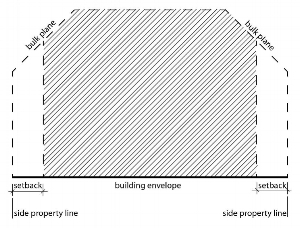I want to add a third floor, but my zoning department says no!
Yes, even as well-groomed adults in complete mastery of our emotions and tempers, having a face-less entity deny us can tempt the best of us into a hearty tantrum. Before you start flinging your arms and stamping your feet like a three-year-old facing a time-out, it softens the blow to understand why zoning restrictions exist. The fact is that they are there to protect all of us and our property values from our neighbors. You may have impeccable taste, but not all of your neighbors do. Zoning codes are there to help neighborhoods be cohesive, primarily through house location on each parcel of land and home size. If you live in a single-family home, after all, you probably would rather not live next door to a skyscraper.
So how do I know what my zoning restrictions are? Thanks to the internet, your local zoning department will probably have a website. To find it, we recommend searching the terms zoning, gov and your city or county's name. If you're lucky, there you will find a map indicating your home's zoning district and a complete list of zoning codes. If not, you should be able to find a phone number you can call. Be patient when calling (or having any communication with your zoning department). Most permit review departments are understaffed and overworked.
Once you obtain access to your zoning department's map, it will give you your property's zoning, probably a list of letters and/or numbers. For example, a common zoning that we work with is E-SU-G. This may seem like gobblety gook at first, but your city or its website will be able to decipher this for you. In my case, the first letter stands for general neighborhood type: E is Urban Edge. The second letter set stands for density type: SU means Single Unit. And the last letter indicates the subcategory that my client's home feel into. And no, I did not know what any of these letters meant when I looked my client's home up. Like you, I have better things to fill my memory bank up with than zoning labels. I simply had the department tell me, in this case on their website.
So now you have your zoning district. Time to examine your zoning codes. And if you had a previous tantrum cut short at the beginning of this article, now would be a good time to indulge. The codes look horrifying at first. Ok, tantrum over. They're really not that bad. They just look it. All code books are set up differently, but they should be organized in such a way that you will be able to discover which codes apply to your zoning district. Below are some steps to help you navigate your zoning codes. However, as each city's code book is set up differently, you may find it a challenge to apply the steps below to your own situation. If that's the case, don't pull your hair out. Make a call to your zoning department. They most likely know these codes like the back of their hands. Let them give you a quick tour. Save the headache! They're there to help you.
Keep your zoning district label handy.
Narrow your search. Your codes should be set up in a way that allows you to focus only on the codes applicable to your property. For example, in my city's seemingly overwhelming multi-volume set of zoning codes, my client's zoning district label E-SU-G tells me to look at the volume dedicated to E.
Find your "Primary Building Form" (aka allowed building type). Once in volume E, I find a matrix that tells me what primary building forms are permitted for E-SU-G: Suburban and Urban Houses.
Locate the primary building forms you are permitted. For me, just one page down are sets of codes with explanatory drawings for each building form. Since I'm only allowed Suburban or Urban, I'm going to focus on those and dismiss the rest.
Analyze the building forms available to you. Each building form should be accompanied by a list of code restrictions. There may be few, there may be many. Either way, allow your architect to take on the headache of reviewing them in detail to understand every nuance of what is and is not permitted. At this stage, though, when you are just trying to understand generally what will and will not be allowed, we recommend focusing on four sets of restrictions, as explained below: use, height, setbacks, and lot coverage. For those of you contemplating a detached dwelling (aka a separated guest house) or a detached garage, we also recommend reviewing your 'detached accessory structures.'
Use. You are in a neighborhood of single family homes and you want to build a single family home, what's the problem? It's simple. In real estate speak, single family homes cover any and all detached homes. In zoning language, though, single-family homes usually cover many zoning types. Examples may include Suburban and Urban. It's important to read the code to understand which uses your property is eligible.
Height. Following your property's zoning and use, the code should lead you to a set of height restrictions. They include the absolute height limitation in feet and in levels permitted above ground, and the bulk plane. In an effort to preserve access to daylight to neighboring properties, zoning departments tend to allow homes to be taller in the center of each property, tapering down as they approach the side neighbors. To achieve this, bulk planes were introduced. They are invisible lines that determine the angle of the tapered height restriction. The codes should give you a bulk plane height and angle. The height is generally measured at the property line. Once you have this, you draw a line from this point to the property's absolute height limit, following the bulk plane angle.
Please note, some zoning departments will specify different height restrictions depending on area of the property. For instance, Denver splits their parcels into a front and rear part, each with different restrictions.
Setbacks. Setbacks determine where on the property a home can be. They are generally divided into front, sides and rear. Overall, they are straight forward. They tell you so many feet, and that's how far you must be from that particular property line. However, many districts will allow certain architectural features to protrude through a setback. Check with your local zoning codes to discover which ones you're permitted.
Lot Coverage. Oftentimes, zoning districts have regulations governing how much of each property can be covered by a structure, such as a home or covered patio.
Detached Accessory Structures. These structures are the detached secondary structures that you will be allowed to build on your property, such as guest houses and garages. Depending on your zoning district. You may be allowed several, or you may be denied any. These secondary structures often follow a different set of setbacks and height restrictions, as listed in your local code book. However, if it's not easy to find, you can always call your local zoning department or rely on your architect to figure it out for you.
Choose the building form that fits your needs the best. Based on the information you gleaned in Step 5, select the building form that meets the majority of your needs.
Hopefully these steps help make reading and understanding your zoning codes less of a chore. And just remember, the more you do learn about your zoning, the more shape you can start to give your dreams of a new or remodeled home. Do keep in mind, though, every code has its nuances. We highly recommend that you contact your local zoning department as well as your architect to verify your findings and confirm that you have not overlooked anything crucial.
Other restrictions you may want to consider looking into at this early stage in conjunction with zoning are those imposed by Landmark if you are in an historic district, your neighborhood if there are covenants, or your parks or city planning departments if your property is in an area governed by city beautifying efforts such as view sheds. Your zoning department will be able to help you determine if any of the above (except for neighborhood covenants) applies to you and, if they do, where to get more information.
For more help, see your Architect or, if you don't have one yet, feel free to reach out to us on our consultation page (link above and to the right).
Example setback diagram.

